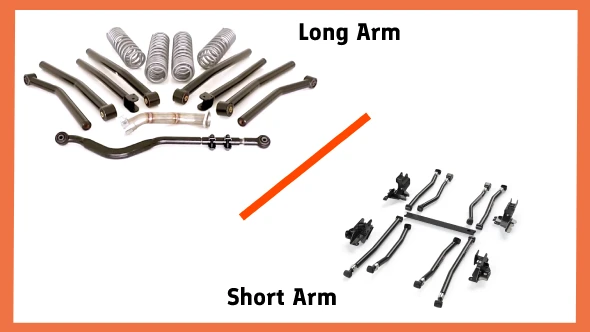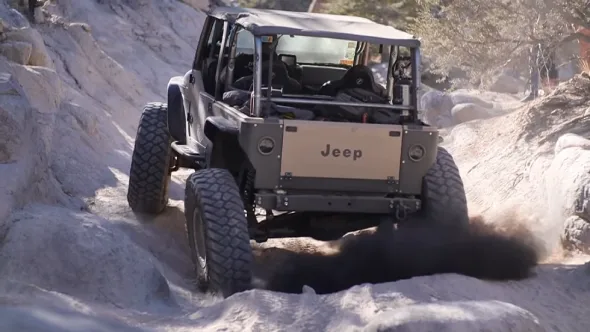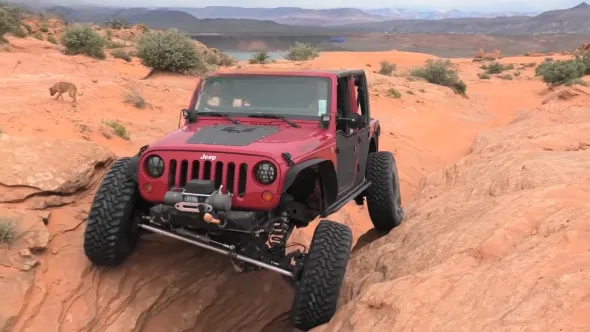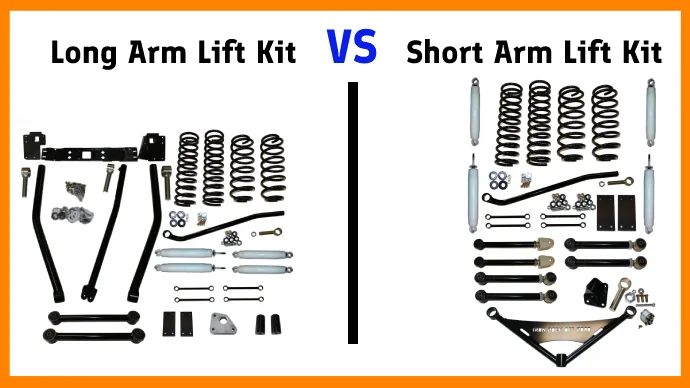Last Updated on April 15, 2023
If you’re looking to upgrade your off-road vehicle, whether it’s a truck, SUV, or Jeep, you’ll need to know the difference between the long-arm lift kit and short-arm lift kit.
Both powerful tools can significantly increase your vehicle’s ground clearance and make it more capable on off-road trails. But there are some key differences in terms of cost, installation difficulty and suspension height that you should be aware of before making your decision.
Short-arm lift kits offer 3.5-inch suspension but require less installation time and money than long-arm lift kits. The long arm lift kits offer 4 inches or higher suspension lift but are more expensive and take longer to install.
You can switch from a short-arm suspension system to a long-arm setup later, but the opposite isn’t true if you start with a long arm.
If you’re torn between short and long-arm suspension systems, we’ve got some great info ahead to help you choose. Let’s explore the differences in more detail to determine which system fits best for you.
Differences Between Long Arm Lift Kit vs Short Arm

Off-roading with trucks, SUVs, or Jeeps can be taken to the next level with lift kits that boost ground clearance and give you better off-road performance. But which type of kit should you choose? Here’s what makes a long-arm lift different from a short-arm lift kit:
1. Arm Length
The primary difference between long-arm and short-arm lift kits is the length of the control arms. Short arm lift kits use stock-length control arms, meaning they have the same length as those originally supplied with your vehicle.
In comparison, long-arm lift kits replace the stock control arms with longer ones to give you more ground clearance and better off-road performance.
2. Suspension Flexibility
Long-arm lift kits provide more suspension travel and flexibility than short-arm lift kits. This increased flexibility helps maintain better traction over rough terrain, as well as absorb larger impacts from obstacles like bumps or dips in the road.
The longer control arms also improve articulation and allow different angles of approach when traversing off-road terrain. As a result, your vehicle can climb up steep inclines and maneuver through tight turns without sacrificing comfort or stability for its passengers.
In addition to enhancing off-road performance, a long arm kit’s suspension flexibly also provides many advantages for on-road driving too.
It helps reduce ride harshness by absorbing shocks from road imperfections like potholes or speed bumps, providing a smoother ride and improved handling characteristics on paved roads.
3. Cost
Long-arm lift kits are significantly more costly than short-arm lift kits due to the number of components required and the custom fabrication necessary for installation.
A long arm kit usually comes with extra suspension arms, brackets, links, and other mounting hardware that have to be made, which adds to the cost.
Conversely, short arm lift kits are cheaper because they only require minor modifications to stock Jeep control brackets, and no extra welding or fabrication is needed.
4. Installation Difficulty
The installation process for long-arm lift kits is much more complex than that of short-arm lift kits. Besides removing and replacing the Jeep control brackets, they also require welding, fabrication, and replacing several driveline and suspension parts.
As a result, it’s best to use qualified professionals from a specialized 4×4 shop when installing long arm lift kits to ensure quality workmanship and avoid potential issues down the line.
Alternatively, short arm lift kits are relatively easy to install since there’s no need for welding or fabrication, just minor modifications to existing stock Jeep control brackets.
5. Lift Height
Long-arm lift kits are typically designed to provide a greater lift height than short-arm lift kits.
This is due to the extra suspension travel that the longer control arms allow, which is essential for helping maintain proper alignment and steering geometry needed for higher lift heights.
Short-arm lift kits tend to be limited to around 3.5 inches of lift, while long-arm lift kits can easily reach 4 inches or more of additional height.
6. Weight
Long-arm lift kits’ additional components and materials make them heavier than short-arm lift kits. A long-arm lift kit has longer control arms, custom brackets, extra hardware, and other heavier parts.
On top of that, the extra suspension travel and flexibility of long-arm lift kits require stronger components that add to their weight.
In contrast, short-arm lifts don’t need as much weight to support their reduced suspension travel, so they are generally lighter than long-arm lift kits.
7. Durability
Regarding durability, long-arm lift kits have the edge over short-arm lifts. This is because they provide more suspension travel which helps absorb impacts far better and reduces the stress on the suspension components when driving off-road.
Also, long arms tend to be constructed from sturdier materials such as steel whereas short arms can sometimes be made from lighter materials like aluminum which can reduce their overall strength and durability.
8. Customization
Long arm lift kits offer greater customization options than short arm lifts since they require more custom work and fabrication.
This allows for unique modifications tailored to specific off-road needs or preferences that wouldn’t be possible with a standard short-arm kit.
The increased flexibility of a long-arm kit also makes it easier to make adjustments to achieve the desired performance specifications for any given situation.
9. Ride Quality
Long-arm lift kits provide a much smoother ride over rough terrain than short-arm lift kits. Because the longer control arms help to distribute the impact of bumps and obstacles across a larger suspension area.
This reduces the jarring effect on the vehicle, making it less likely for its passengers to be jostled around. On the other hand, long-arm lift kits are more susceptible to getting stuck on rocks and other large objects on the road.
10. Maintenance
In terms of maintenance, long-arm lift kits may require more attention than short-arm lift kits. This is because they have more moving parts, such as bushings and joints, that need to be regularly replaced or lubricated.
Also, long arms are usually made from heavier materials, which can add extra stress to the suspension system over time if not properly maintained.
On the other hand, short arm lifts typically require less maintenance since they tend to be made from lighter materials with fewer moving parts.
Do Long Arm Lift Kits and Short Arm Lift Kits Affect the Vehicle’s Handling And Stability?

Both short-arm and long-arm lift kits can affect a vehicle’s handling and stability in different ways.
A long-arm lift kit can provide substantial off-road benefits, so they are commonly used for vehicles intended mainly for off-roading.
But, the vehicle’s behavior on paved roads can be negatively impacted by a long arm setup, more body roll, more difficult steering, and more instability are just some of the issues associated with this type of lift.
On the other hand, a short-arm jeep lift kit usually involves adding spacers or blocks to the existing suspension components, which increases the distance between the axle and the frame without changing the suspension geometry. They may impact the vehicle’s handling and stability less than a long arm lift kit.
Ultimately, the impact of a lift kit on a vehicle’s handling and stability will depend on various factors, such as the type and quality of the kit, the vehicle’s weight and size, and the driving conditions.
How Long Do Long and Short Arm Lift Kits Last?
Short and long-arm lift kits tend to last many years if properly maintained. How well a lift kit is cared for, what kind of parts are used, and how often it’s used determine its longevity.
Generally, long-arm lift kits tend to last longer than short-arm lift kits because they have more suspension travel and can better absorb shock from off-road terrain. Also, long-arm lift kits are usually made with higher-quality materials than short-arm lift kits, making them more durable over time.
It’s important to regularly inspect your long or short-arm lift kit to make sure it’s not wrecked, as this can affect its lifespan.
Aside from that, you should check all nuts and bolts periodically to ensure that everything is securely fastened. Use the correct suspension oil when servicing your kit to keep it running smoothly.
Which Lift Kit Is Best For You: Long Arm Or Short Arm?

Choosing whether to use a long-arm or short arm kit ultimately depends on your specific needs. If you are only looking to lift your rig up to 3.5 inches and do lots of rock crawling, then a short arm lift kit is likely the best choice for you.
Short arm kits are designed to increase vehicle clearance, which will give you more room when off-roading in rocky terrain. Also, if you plan to upgrade your rig down the line, it may be beneficial to go with a shorter arm now, as it can make switching over to a long arm easier later.
On the other hand, if you plan to use your vehicle as a daily driver and primarily do fast off-roading, then a long arm lift kit is probably the way to go.
Long arms provide superior stability over shorter arms because they have greater leverage for suspension articulation. This allows for greater control over larger bumps and dips in the road, providing a smoother ride compared to the harsher ride of short arms.
Furthermore, long arms can accommodate lifts up to 4 inches, so you can achieve higher ground clearance without worrying about compromising performance or safety.
Both short and long-arm kits offer great benefits depending on what type of driving and terrain you will encounter most often. Be sure to consider all options when making your decision so that you get the most out of your rig.
Opting for Off-Road Performance: Compare Long and Short Lift Kits Today
Choosing between a long-arm or short-arm lift kit for your off-road vehicle requires careful consideration of all the factors involved. Short-arm kits are less expensive and easier to install but offer less suspension than the longer counterparts.
Long arm lift kits will provide more ground clearance and off-roading capability but cannot be reverted back after installation. Ultimately, it boils down to personal preference and what meets your needs best based on cost, installation difficulty, and suspension level desired.
